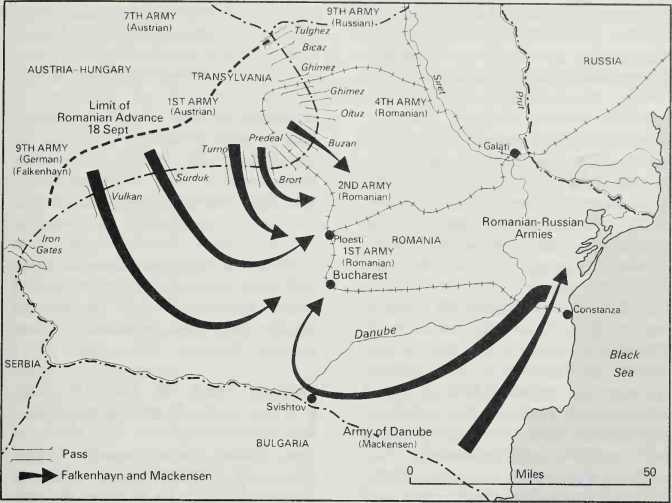
Romanian campaign, August 1916 - January 1917; victory for the Central Powers
Into the Allied camp. If the decision had been made earlier in the summer, it is possible that Austria-Hungary would have been knocked out, for its German allies were heavily embroiled on the Western Front; but Prime Minister Ion Bratiano and his cabinet delayed to squeeze the best possible terms out of their prospective allies. Apart from more offensive action from the near-exhausted Russians, Bratiano called first for an offensive from the Anglo-French force at Salonika; second, for the deployment of three Russian divisions to guarantee sovereignty over Transylvania. Bukovina and other territories; and third, for 300 tons of munitions to be delivered daily at the port of Constanta. Agreement was not reached until late August. The Romanians mobilized on the 27th and declared war on the Central Powers. The Romanian army was
500,000 strong but was basically a militia army, lacking modern weaponry, particularly artillery and aircraft, and with only six weeks’ war reserves. Its officer corps was largely weak and corrupt.
On August 28, the Romanians advanced through the high passes into Transylvania. Initially all went well and in three days advances of up to 45 miles (72km) had been made. It was then that the German General Staff showed its mettle. Hindenburg and Luden-dorff assumed supreme direction of operations in place of Gen von Falkenhayn who, following his forced resignation on August 28 and anxious to make good his military reputation, was appointed to command German Ninth Army in Transylvania. By mid-September he had stabilized the line, steadied Austrian First Army and was ready to counterattack. Meanwhile, on September 1, Bulgaria joined the war on the side of the Central Powers, adding her troops to Field Marshal August von Mackensen’s German/Turkish Army of the Danube, which crossed into Southern Romania from Bulgaria on September 1 and made for the key port of Constanta. Although they cut the Constan-ta-Bucharest railway, vigorous counterattacks by Russian, Romanian and Serbian troops halted them and Mackensen, with most of his army, doubled back, crossed the Danube at Svishtov and made for Bucharest. On October 23, Mackensen’s troops took Constanta, cutting off the meagre flow of Allied munitions.
Falkenhayn had now. thrown the Romanians back through the passes and was ready to coordinate with Mackensen in a drive against Bucharest and the oil town of Ploesti. The Romanians tried desperately to prevent the junction of their opponents’ armies, but
Bucharest fell on December 6 and on January 17 1917 the last Romanian divisions fell back behind the line of the River Siret, where they remained for the rest of the war. Well over 300,000 Romanian soldiers had become casualties and their country was effectively out of the war. The Central Powers now held the oilfields and the wheat and the Allies had experienced a major p. sychological defeat. MH.
Rome, capture of (1944) see anzio,
ALLIED BREAKOUT FROM.
Rome, march on (1922). Italian political chaos in autumn 1922 led to fascist threats to seize power. On October 29 Mussolini was summoned to Rome and requested to form a government. His supporters’ planned “march” on Rome never materialized; instead,
25,000 blackshirts arrived by train for a victory parade.
Rommel, Field Marshal Erwin
(1891—1944). Ger. Came to Hitler’s attention as Commander 7th Panzer Division in the invasion of France in June 1940; appointed to command the Afrika Korps, he landed at Tripoli in February 1941 with the task of stopping the British conquest of Libya. Despite High Command objections, he invaded Cyrenaica in April 1941, driving the British back.
He defeated two attempts to relieve Tobruk in the summer of 1941, but was himself defeated by Eighth Army during its “Crusader” offensive in November 1941, and was forced to raise the siege of Tobruk. He withdrew into Tripoli-tania to await tank replacements. Nevertheless, his operations in the Western Desert earned him the title of “the Desert Fox”.
In January 1942, he counterattacked, driving Eighth Army back towards Tobruk. In the Battle of Gazala in June he won tank superiority, took Tobruk, and advanced to El Alamein. Promoted Field Marshal, he was then decisively defeated by Gen Montgomery at Alam Haifa and El Alamein that autumn, and was forced to withdraw to Tunisia. He was again defeated by Montgomery at Mede-nine, leaving Africa in March 1943 due to ill health and intrigue in the Axis High Command.




 World History
World History









